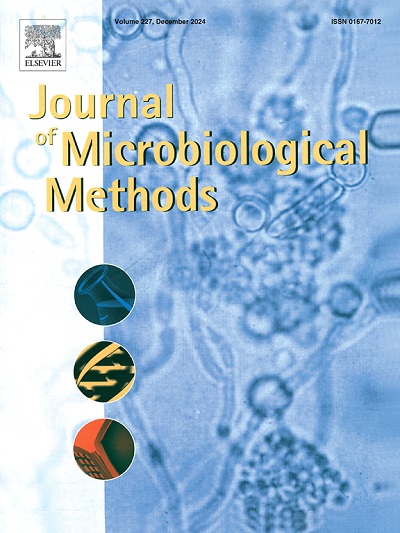用Raman-DIP评价硝基喹啉对鲍曼不动杆菌的双相杀菌活性。
IF 1.9
4区 生物学
Q4 BIOCHEMICAL RESEARCH METHODS
引用次数: 0
摘要
鲍曼不动杆菌抗微生物药物耐药性(AMR)的增加对临床管理提出了挑战,并强调了其作为难治性尿路感染(uti)的关键病原体的作用。硝基喹啉作为一种潜在的治疗选择重新引起了人们的兴趣。拉曼氘稳定同位素探测(Raman- dip),允许分析细菌代谢活性,已经显示出作为评估抗菌功效的工具的前景。本研究的目的是评价硝基喹啉对鲍曼不动杆菌的杀菌活性,并探讨Raman-DIP对该活性的评价潜力。从尿路感染患者中分离出34株鲍曼不动杆菌。测定最小抑菌浓度(mic)、最小杀菌浓度(MBCs)、最佳杀菌浓度(OBCs)和时间杀伤曲线。Raman-DIP利用CD比(CD与C - H和C - D波段强度之和)作为代谢活性指标,评估硝基喹啉对细菌代谢和存活的影响。硝基喹啉对鲍曼不动杆菌具有较强的抑菌活性,MIC50/90和MBC50/90分别为2/2和2/4 mg/L。值得注意的是,它具有双相杀菌特性,OBC50/90值为4/8 mg/L。Raman-DIP显示,随着硝基喹啉浓度的增加,CD比降低,表明代谢活性降低。在浓度高于OBC时,观察到细菌存活率与CD比呈负相关。这些发现强调了优化给药方案以提高硝基喹啉疗效的必要性。Raman-DIP可作为研究硝基喹啉对细菌代谢影响的有效工具,为其临床应用提供依据。本文章由计算机程序翻译,如有差异,请以英文原文为准。

Biphasic bactericidal activity of nitroxoline against Acinetobacter baumannii assessed by Raman-DIP
The increasing antimicrobial resistance (AMR) of Acinetobacter baumannii presents a challenge to clinical management and underscores its role as a critical pathogen in refractory urinary tract infections (UTIs). Nitroxoline has gained renewed interest as a potential therapeutic option. Raman deuterium stable isotope probing (Raman-DIP), which allows for the analysis of bacterial metabolic activity, has shown promise as a tool for assessing antimicrobial efficacy. The aim of this study was to evaluate the bactericidal activity of nitroxoline against A. baumannii and the potential of Raman-DIP to assess this activity. Thirty-four A. baumannii isolates were collected from patients with UTI. Minimum inhibitory concentrations (MICs), minimum bactericidal concentrations (MBCs), optimal bactericidal concentrations (OBCs), and time–killing curves were determined. Raman-DIP evaluated nitroxoline's effects on bacterial metabolism and survival, using the C−D ratio (C−D to the sum of the C − H and C − D band intensities) as a metabolic activity metric. Nitroxoline demonstrated potent antimicrobial activity against A. baumannii, with MIC50/90 and MBC50/90 values of 2/2 and 2/4 mg/L, respectively. Notably, it showed biphasic bactericidal characteristics with an OBC50/90 value of 4/8 mg/L. Raman-DIP revealed a decrease in the C−D ratio with an increase in nitroxoline concentration, indicating reduced metabolic activity. An inverse correlation was observed between bacterial survival and the C−D ratio at concentrations above the OBC. These findings underscore the necessity to optimize dosing regimens for enhancing the efficacy of nitroxoline. Raman-DIP may serve as an effective tool for investigating the effect of nitroxoline on bacterial metabolism, thereby informing its clinical applications.
求助全文
通过发布文献求助,成功后即可免费获取论文全文。
去求助
来源期刊

Journal of microbiological methods
生物-生化研究方法
CiteScore
4.30
自引率
4.50%
发文量
151
审稿时长
29 days
期刊介绍:
The Journal of Microbiological Methods publishes scholarly and original articles, notes and review articles. These articles must include novel and/or state-of-the-art methods, or significant improvements to existing methods. Novel and innovative applications of current methods that are validated and useful will also be published. JMM strives for scholarship, innovation and excellence. This demands scientific rigour, the best available methods and technologies, correctly replicated experiments/tests, the inclusion of proper controls, calibrations, and the correct statistical analysis. The presentation of the data must support the interpretation of the method/approach.
All aspects of microbiology are covered, except virology. These include agricultural microbiology, applied and environmental microbiology, bioassays, bioinformatics, biotechnology, biochemical microbiology, clinical microbiology, diagnostics, food monitoring and quality control microbiology, microbial genetics and genomics, geomicrobiology, microbiome methods regardless of habitat, high through-put sequencing methods and analysis, microbial pathogenesis and host responses, metabolomics, metagenomics, metaproteomics, microbial ecology and diversity, microbial physiology, microbial ultra-structure, microscopic and imaging methods, molecular microbiology, mycology, novel mathematical microbiology and modelling, parasitology, plant-microbe interactions, protein markers/profiles, proteomics, pyrosequencing, public health microbiology, radioisotopes applied to microbiology, robotics applied to microbiological methods,rumen microbiology, microbiological methods for space missions and extreme environments, sampling methods and samplers, soil and sediment microbiology, transcriptomics, veterinary microbiology, sero-diagnostics and typing/identification.
 求助内容:
求助内容: 应助结果提醒方式:
应助结果提醒方式:


